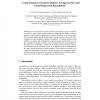PR
2008
15 years 4 days ago
2008
For two-class discrimination, Ref. [1] claimed that, when covariance matrices of the two classes were unequal, a (class) unbalanced dataset had a negative effect on the performanc...
CORR
2007
Springer
15 years 5 days ago
2007
Springer
—Situations in many fields of research, such as digital communications, nuclear physics and mathematical finance, can be modelled with random matrices. When the matrices get la...
114
click to vote
NIPS
1998
15 years 1 months ago
1998
We describe a new iterative method for parameter estimation of Gaussian mixtures. The new method is based on a framework developed by Kivinen and Warmuth for supervised on-line le...
121
Voted
BMVC
1998
15 years 1 months ago
1998
We consider reconstruction algorithms using points tracked over a sequence of (at least three) images, to estimate the positions of the cameras (motion parameters), the 3D coordin...
93
Voted
DAGM
2000
Springer
15 years 4 months ago
2000
Springer
Abstract. In this paper we present di erent approaches to structuring covariance matrices within statistical classi ers. This is motivated by the fact that the use of full covarian...
90
Voted
AVBPA
2001
Springer
15 years 4 months ago
2001
Springer
In several pattern recognition problems, particularly in image recognition ones, there are often a large number of features available, but the number of training samples for each p...
ICPR
2010
IEEE
15 years 5 months ago
2010
IEEE
Covariance matrices have recently been a popular choice for versatile tasks like recognition and tracking due to their powerful properties as local descriptor and their low comput...
109
Voted
AVBPA
2003
Springer
15 years 5 months ago
2003
Springer
The quadratic discriminant (QD) classifier has proved to be simple and effective in many pattern recognition problems. However, it requires the computation of the inverse of the sa...
IWANN
2005
Springer
15 years 5 months ago
2005
Springer
Linear Discriminant Analysis (LDA) technique is an important and well-developed area of image recognition and to date many linear discrimination methods have been put forward. Desp...
ICNC
2005
Springer
15 years 5 months ago
2005
Springer
Principal Component Analysis (PCA) and Linear Discriminant Analysis (LDA) techniques are important and well-developed area of image recognition and to date many linear discriminati...





